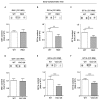Impaired Levels of Gangliosides in the Corpus Callosum of Huntington Disease Animal Models
- PMID: 27766070
- PMCID: PMC5052274
- DOI: 10.3389/fnins.2016.00457
Impaired Levels of Gangliosides in the Corpus Callosum of Huntington Disease Animal Models
Abstract
Huntington Disease (HD) is a genetic neurodegenerative disorder characterized by broad types of cellular and molecular dysfunctions that may affect both neuronal and non-neuronal cell populations. Among all the molecular mechanisms underlying the complex pathogenesis of the disease, alteration of sphingolipids has been identified as one of the most important determinants in the last years. In the present study, besides the purpose of further confirming the evidence of perturbed metabolism of gangliosides GM1, GD1a, and GT1b the most abundant cerebral glycosphingolipids, in the striatal and cortical tissues of HD transgenic mice, we aimed to test the hypothesis that abnormal levels of these lipids may be found also in the corpus callosum white matter, a ganglioside-enriched brain region described being dysfunctional early in the disease. Semi-quantitative analysis of GM1, GD1a, and GT1b content indicated that ganglioside metabolism is a common feature in two different HD animal models (YAC128 and R6/2 mice) and importantly, demonstrated that levels of these gangliosides were significantly reduced in the corpus callosum white matter of both models starting from the early stages of the disease. Besides corroborating the evidence of aberrant ganglioside metabolism in HD, here, we found out for the first time, that ganglioside dysfunction is an early event in HD models and it may potentially represent a critical molecular change influencing the pathogenesis of the disease.
Keywords: Corpus Callosum White Matter (CC-WM); GD1a; GM1; GT1b; Gangliosides; HD.
Figures





Similar articles
-
Disease-modifying effects of ganglioside GM1 in Huntington's disease models.EMBO Mol Med. 2017 Nov;9(11):1537-1557. doi: 10.15252/emmm.201707763. EMBO Mol Med. 2017. PMID: 28993428 Free PMC article.
-
Topographical atlas of the gangliosides of the adult human brain.J Neurochem. 1984 Oct;43(4):979-89. doi: 10.1111/j.1471-4159.1984.tb12833.x. J Neurochem. 1984. PMID: 6470716
-
Age-related changes in GM1, GD1a, GT1b components of gangliosides in Wistar albino rats.Cell Biochem Funct. 2000 Mar;18(1):41-5. doi: 10.1002/(SICI)1099-0844(200001/03)18:1<41::AID-CBF846>3.0.CO;2-W. Cell Biochem Funct. 2000. PMID: 10686582
-
Gangliosides in the Brain: Physiology, Pathophysiology and Therapeutic Applications.Front Neurosci. 2020 Oct 6;14:572965. doi: 10.3389/fnins.2020.572965. eCollection 2020. Front Neurosci. 2020. PMID: 33117120 Free PMC article. Review.
-
Gangliosides of the Vertebrate Nervous System.J Mol Biol. 2016 Aug 14;428(16):3325-3336. doi: 10.1016/j.jmb.2016.05.020. Epub 2016 May 31. J Mol Biol. 2016. PMID: 27261254 Free PMC article. Review.
Cited by
-
Potential Circadian Rhythms in Oligodendrocytes? Working Together Through Time.Neurochem Res. 2020 Mar;45(3):591-605. doi: 10.1007/s11064-019-02778-5. Epub 2019 Mar 25. Neurochem Res. 2020. PMID: 30906970 Free PMC article. Review.
-
Treatment with THI, an inhibitor of sphingosine-1-phosphate lyase, modulates glycosphingolipid metabolism and results therapeutically effective in experimental models of Huntington's disease.Mol Ther. 2023 Jan 4;31(1):282-299. doi: 10.1016/j.ymthe.2022.09.004. Epub 2022 Sep 16. Mol Ther. 2023. PMID: 36116006 Free PMC article.
-
Gangliosides as Biomarkers of Human Brain Diseases: Trends in Discovery and Characterization by High-Performance Mass Spectrometry.Int J Mol Sci. 2022 Jan 8;23(2):693. doi: 10.3390/ijms23020693. Int J Mol Sci. 2022. PMID: 35054879 Free PMC article. Review.
-
Lipid glycosylation: a primer for histochemists and cell biologists.Histochem Cell Biol. 2017 Feb;147(2):175-198. doi: 10.1007/s00418-016-1518-4. Epub 2016 Dec 20. Histochem Cell Biol. 2017. PMID: 27999995 Review.
-
Manipulation of Ion Types via Gas-Phase Ion/Ion Chemistry for the Structural Characterization of the Glycan Moiety on Gangliosides.Anal Chem. 2021 Nov 30;93(47):15752-15760. doi: 10.1021/acs.analchem.1c03876. Epub 2021 Nov 17. Anal Chem. 2021. PMID: 34788022 Free PMC article.
References
-
- Bohanna I., Georgiou-Karistianis N., Sritharan A., Asadi H., Johnston L., Churchyard A., et al. . (2011). Diffusion tensor imaging in Huntington's disease reveals distinct patterns of white matter degeneration associated with motor and cognitive deficits. Brain Imaging Behav. 5, 171–180. 10.1007/s11682-011-9121-8 - DOI - PubMed
-
- Ciarmiello A., Cannella M., Lastoria S., Simonelli M., Frati L., Rubinsztein D. C., et al. . (2006). Brain white-matter volume loss and glucose hypometabolism precede the clinical symptoms of Huntington's disease. J. Nucl. Med. 47, 215–222. - PubMed
LinkOut - more resources
Full Text Sources
Other Literature Sources
Molecular Biology Databases

